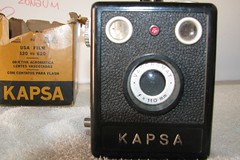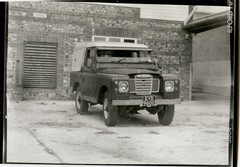Difference between revisions of "Kapsa"
(image added) |
m |
||
| Line 16: | Line 16: | ||
{{Flickr_image | {{Flickr_image | ||
|image_source= http://www.flickr.com/photos/nibelunga/2756499001/in/pool-camerapedia/ | |image_source= http://www.flickr.com/photos/nibelunga/2756499001/in/pool-camerapedia/ | ||
| − | |image= http://farm4.static.flickr.com/3062/ | + | |image= http://farm4.static.flickr.com/3062/2756499001_44df618aff_m.jpg |
|image_align= left | |image_align= left | ||
|image_text= Kapsa Vascromat and box | |image_text= Kapsa Vascromat and box | ||
Revision as of 21:42, 13 April 2011

|

|
| Controls by l. amato |
Kapsa is a Bakelite (and later other plastic) 120 or 620 film 6x9cm/6x4cm box camera made in Sao Paolo, Brazil by D. F. Vasconcellos (DFV)[1]. It was introduced in the early 1950s. There was a hinged mask for conversion to 6x4cm frames. The 110mm Vascromat lens has two auxiliary lenses giving three focus distances; 1-2 metres, 2-8 metres, and 8 metres-infinity. The camera is fitted with a single-leaf leaf shutter with a speed of 1/100 second and B, with three aperture sizes, f22, f16, and f11. On one side it has a metal panel with all the controls except the film advance knob. Of course it has the two brilliant viewfinders which are typical for box cameras.
It was considered a budget camera in comparison to more advanced cameras of the time due to it's limited focusing abilities.

|
| Kapsa Vascromat and box |

|
| Photo taken with the Vascromat at 6x4cm on HP5 |
Sources/links
- "Brazil's Secret Camera"
- Kapsa image on flickr by galessa's plastics
- Kapsa group on flickr